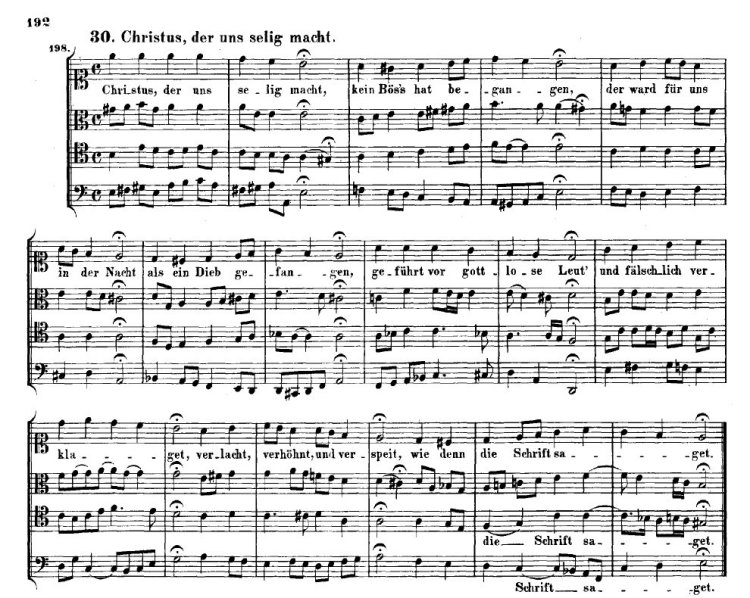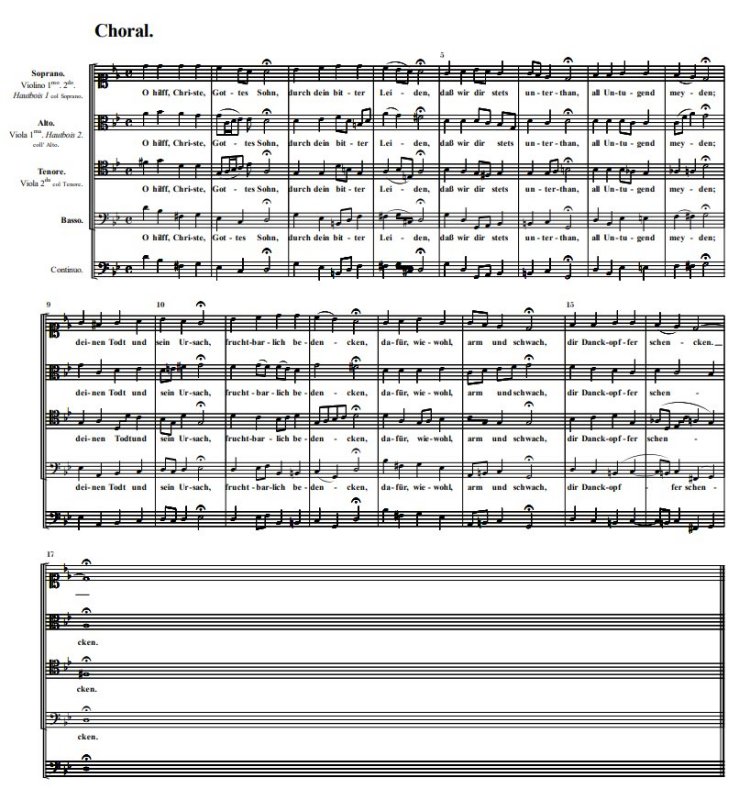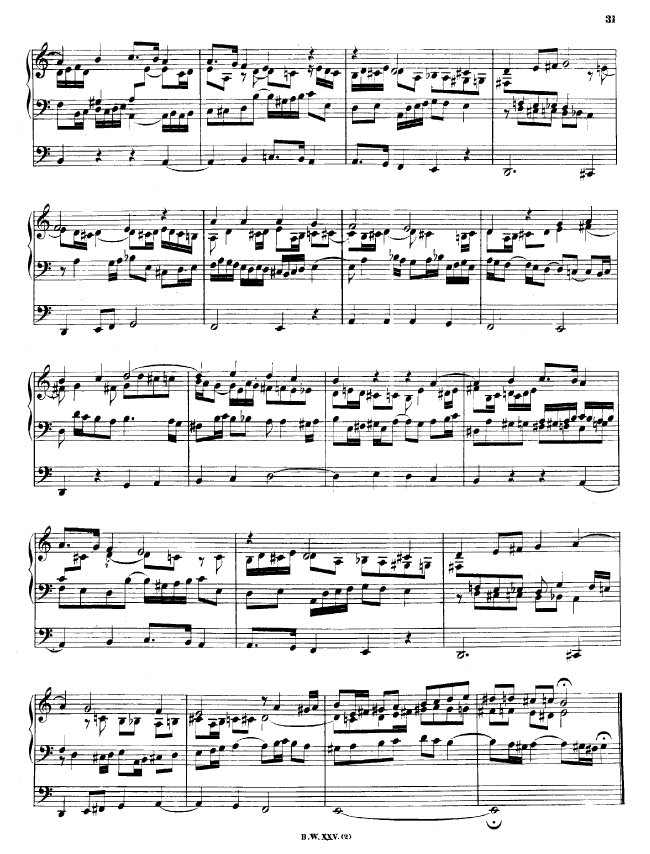|
Chorale Melodies used in Bach's Vocal Works
Christus der uns selig macht |
|
Melody & Text | Use of the CM by Bach | Use of the CM by other composers |
| |
|
Melody & Text: |
|
"Christus, der uns Selig macht" is J.S. Bach's most-often set of Michael Weisse's hymns, for Palm Sunday to Good Friday. It is based on Eigido of Colonna's Patris sapientia, veritas divina (Christ, divine truth, 14th century, Good Friday canonical hours, 28. Hymn: patris sapientia, veritas divina: Google Translate). M. Weisse originally published "Christus, der uns Selig macht" for Lent/Palm Sunday as a continuation of his 22-stanza hymn, "Christus wahrer Gottes Sohn, auf Erden Leibhaftig" (Christ truly God's Son, from earth personified), "which describes Christ's life until the Passion, although separate from it," says Mark S. Bighley. "The various canonical hours are evident in Stanzas 1-7," from Lauds/Matins to Compline, closing with verse eight, "O hilf, Christe! Gottes sohn." It is found in the NLGB as No. 71-I, Passiontide (Zahn melody 6283b) with music (Google Books. The text is found in the Schmelli Gesangbuch (Leipzig 1536) on pages 167f under the rubric Good Friday.
J.S. Bach used "Christus, der uns Selig macht" as four plain chorale Passion settings and the melody in chorale prelude collections, Orgelbüchlein, BWV 620(a) for Passiontide, YouTube), says Peter Williams, and questionable settings, BWV 747, and deest Emans 46 (YouTube). Plain chorale settings appear twice in the St. John Passion (SJP) BWV 245, at the beginning and end of the extended trial before Pilate, opening Part 2, beginning in E Major (no. 15, Bach-Chorales, ) and ending in F Major (no. 37, Bach-Chorales), using the first and last stanza, "O hilf Christe! Gottes Sohn."
J.S. Bach's chorale usage in the SJP generally emphasizes the Christus Victor concept of atonement, notably in the multiple uses of "Christus, der uns Selig macht," as well as the signature chorale, three times (nos.14, 15a, 32), Paul Stockmann’s "Jesu Leiden, Pein und Tod" (Melchior Vulpius' melody “Jesu Kreuz, Leiden und Pein), and “Herzleibster Jesu” twice, (3 and 17). J.S. Bach also set the Phrygian hymn in two other plain chorale Passion contexts: in E Major, BWV 283, Bach-Chorales, possibly in the 1717 Weimar/Gotha Passion oratorio, catalogued as Bach Compendium BC D 1/6=F 31.1, and as BWV 1084 in D Major (Bach-Chorales, in the c1747 St. Mark Passion pasticcio (BNB I/K/2), No. 14, in the same place as BWV 245/37, the end of Jesus' trial before Pilate.
Source: Passiontide Devotional Chorales, Other Weiße Hymns (William Hoffman, February 20, 2018) |
|
Both words and melody of the hymn, “Christus der uns selig macht,” are adapted from the Latin “Patris Sapientia, veritas divina.” The words are by Michael Weisse and were first published, with the tune, in 1531. The melody occurs also in the St John Passion (1723), Nos. 12, 35; Choralgesänge, No. 48; and the Orgelbüchlein.
Both words and melody of the hymn, “Christus der uns selig macht,” are adapted from the Latin “Patris Sapientia, veritas divina.” The words are by Michael Weisse and were first published, with the tune, in 1531. The melody occurs also in the St John Passion (1723), Nos. 12, 35; Choralgesänge, No. 48; and the Orgelbüchlein.
Source: Charles Stanford Terry: Johann Sebastian Bach, Bach’s Chorals, vol. 3 The Hymns and Hymn Melodies of the Organ Works (1921), pp 119-121 |
|
Melody: Zahn 6285
Composer: Anon (Bohemian Brethren, 1501 / 1531) |
|
Bach is not consistent in his statement of the melody. In the Choralgesänge and Orgelbüchlein he adopts the early 1531 text. In the St John Passion he uses a Leipzig reconstruction of the tune which dates from 15981. Witt (No. 95) uses the older form.
Source: Charles Stanford Terry: Johann Sebastian Bach, Bach’s Chorals, vol. 3 The Hymns and Hymn Melodies of the Organ Works (1921), pp 119-121 |
 |
|
Ex 01: Melody: “Patris Sapientia” |
 |
|
Text: Christus, der uns selig macht (NLGB 70; EG 77)
Author: Michael Weisse (1531) |
| |
| |
|
Use of the Chorale Melody by Bach: |
|
Text: |
|
Chorale Christus, der uns selig macht (Mvt. 15) from Johannes-Passion BWV 245 (verse 1)
Ref: RE 81; Br 80; Birnstiel 77; Fasch p.138 |
 |
|
Chorale O hilf, Christe, Gottes Sohn (Mvt. 37) from Johannes-Passion BWV 245 (verse 8)
Ref: RE 113; Br 113; Birnstiel 117; Fasch p.140 |
 |
|
Chorale Christus, der uns selig macht, BWV 283
Ref: RE 198=307; Br 198=306;KE 48; Birnstiel 315; AmB 46II p.91 & p.136; Penzel 131, BGA 30; BC F98.1 |
 |
|
Chorale O hilf, Christe, Gottes Sohn, BWV 1084 (from the Markus-Passion Pasticcio)
Ref: BC D5 |
 |
|
Untexted: |
|
Chorale Prelude Christus, der uns selig macht (I), BWV 620 |
|
The movement is one of the Passiontide Preludes in the Orgelbuchlein. Its fierce intensity is inspired by the first stanza of the hymn, and particularly by the words.
Where they tried their worst effort
’Gainst the Lord of Mercy.
An older text of the movement—that of the Mendelssohn Autograph - is in B.G. xxv. (2) 149 (P. v. 108). |

 |
|
Chorale Prelude Christus, der uns selig macht (II), BWV 620a |
| |
|
Chorale Prelude Christus, der uns selig macht (III), BWV 747 |
| |
| |
| |
|
Use of the Chorale Melody by other composers: |
|
Johann Erasmus Kindermann (1616-1655)
Drifache Fuga super for organ: 1. Christ lag in Todesbanden; 2. Christus der uns selig macht; 3. Da Jesus an dem Creuze stundt (Harmonia organica Nr. 16, 1645) IMSLP |
|
Georg Philipp Telemann (1681-1767)
Chorale Prelude for organ Christus, der uns selig macht, TWV 31:23 |
|
Christoph Graupner (1683-1760):
Cantata Christus, der uns selig macht for Reminiszere/2nd Sunday in Lent, GWV 1121/41 (1741) |
|
Carl Loewe (1796-1869)
Oratorio Die Festzeiten, Op.66 (1825-1836; published: 1842) IMSLP | Musicalion |
|
Ernst Pepping (1901-1981):
Böhmisches Orgelbuch : Choralvorspiele und Orgelchoräle nach Weisen der Bömischen Brüder: Vol. 2. Organ chorales and chorale preludes on Christus, der uns selig macht; Jesu Kreua, Leiden und Pein; Erstanden ist der heilig Christ; and Mit Freuden zart (1953) |
| |
| |
|
Sources: Bach Digital; BGA; Zahn
Photos from Gottfried Vopelius Neu Leipziger Gesangbuch (Vopelius 1682), were from a digital copy of the book downloaded from Bayerische Staatsbibliothek München. This copy is Out of copyright - non commercial re-use (Europeana Rights).
Prepared by Aryeh Oron (October 2018 - July 2023) |